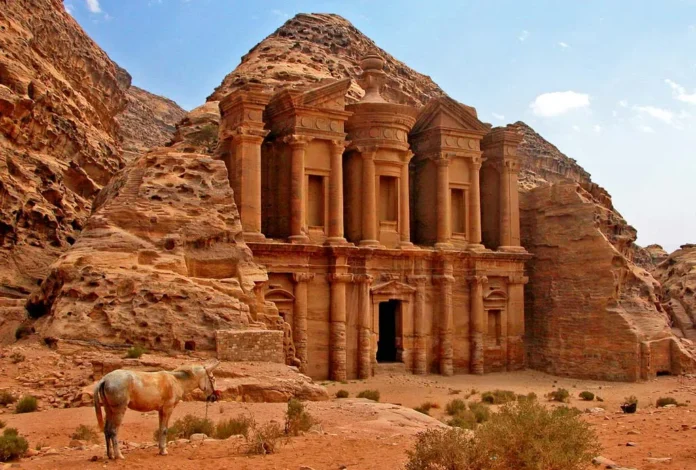Petra, located in southern Jordan’s southwestern desert, is a historic and archaeological city known to its inhabitants as Raqmu. Famous for its rock-cut architecture and water conduit system, Petra spans an area of 264 square kilometers and dates back to the early 5th century BC. The name “Petra” translates to “stone” or “rock” in English.
The city is situated around Jabal Al Madbah, in a basin surrounded by mountains that form the eastern flank of the Arabah Valley, which stretches from the Dead Sea to the Gulf of Aqaba. Petra is accessed through a narrow canyon called Al Siq, which leads to a landscape filled with tombs and temples carved into pink sandstone cliffs, earning it the nickname “Rose City.”
The most famous structure in Petra is Al Khazneh, a 45-meter-high temple with an ornate Greek-style façade, which served as a treasury. In 1985, Petra was designated a UNESCO World Heritage Site and described as one of the most precious cultural properties of mankind’s heritage. In 2007, it was voted one of the New Seven Wonders of the World by over 100 million people.
Petra was built by the Nabataeans, nomadic Arabs who settled there in the 4th century BC, establishing Petra as their kingdom. The area around Petra had been inhabited as early as 7000 BC. The Nabataeans invested in trade routes, making Petra a major regional trading hub. According to recent studies, Petra’s stone-hewn city was strategically built so the sun would illuminate its sacred places like celestial spotlights. Historically, the Prophet Aaron’s body is said to be buried on a mountain summit in Petra.
A walk through Petra from the entrance to the treasury takes about 30 minutes and covers a distance of 2 kilometers. Petra was a significant religious center, with the Nabataeans constructing tombs, temples, altars, and sanctuaries for their gods. Later, it became home to at least one Byzantine church. Key sites within Petra include the Obelisk Tomb, Qasr al-Bint, the Hadrian Gate, the Garden Temple, the Coloured Triclinium, and the Urn Tomb.
The official currency in Petra is the Jordanian Dinar, but Pounds, US Dollars, and Euros can be exchanged in Jordan. Petra is considered a safe city to visit, with no specific travel advisories against it, although the US State Department and British Foreign Office advise caution near the borders with Syria and Iraq. Petra’s primary religions include Christianity and an earlier form of Arab polytheism practiced by the Nabataeans.
Visitors to Petra should dress modestly, with women advised to wear t-shirts or long-sleeve tops and longer tunic-style tops to cover tight pants or leggings. This adherence to modest dress is important due to local customs.
Overall, Petra is a highly recommended destination for travelers worldwide, offering a rich historical and cultural experience within a reasonable budget.
Weather in Petra
Petra experiences a mild and dry climate year-round, with average temperatures ranging from 8.5°C to 26.5°C. Summers are hot, while winters are semi-cold. The most rainfall occurs during the winter months, particularly in December, January, and February. Some snowfall may also occur during these months. Throughout the year, Petra receives rainfall on 22 days, totaling approximately 86mm.
The best time to visit Petra is during the spring and autumn months of April, May, October, and November. During this period, the weather is dry and not excessively hot, making it comfortable for exploring the ancient city. Additionally, visitor numbers tend to be smaller during these months, allowing for a more enjoyable and less crowded experience.
Petra Culture
Petra’s rich cultural heritage extends beyond its ancient ruins, encompassing literature, films, television, music, and even video games. In literature, Petra has been featured in various novels, including “The Eagle in the Sand,” “The Red Sea Sharks,” “The Adventures of Tintin,” and “The Moon Goddess and the Son.” It played a prominent role in Marcus Didius Falco mystery novels as well.
The iconic city has also graced the silver screen, appearing in films like “Arabian Nights,” “Passion in the Desert,” “Mortal Kombat,” “The Mummy Returns,” and “Krrish 3.” Its mystique was further explored in the American PBS Nova special television drama titled “Petra: Lost City of Stones.”
Petra’s influence extends into the realm of music, with appearances in the video for the Urban Species single “Spiritual Love” in 1994. Additionally, Petra serves as a free play map in the popular video game Overwatch, allowing players to explore its ancient wonders virtually. Through these various mediums, Petra continues to captivate audiences worldwide, showcasing its enduring allure and cultural significance.


